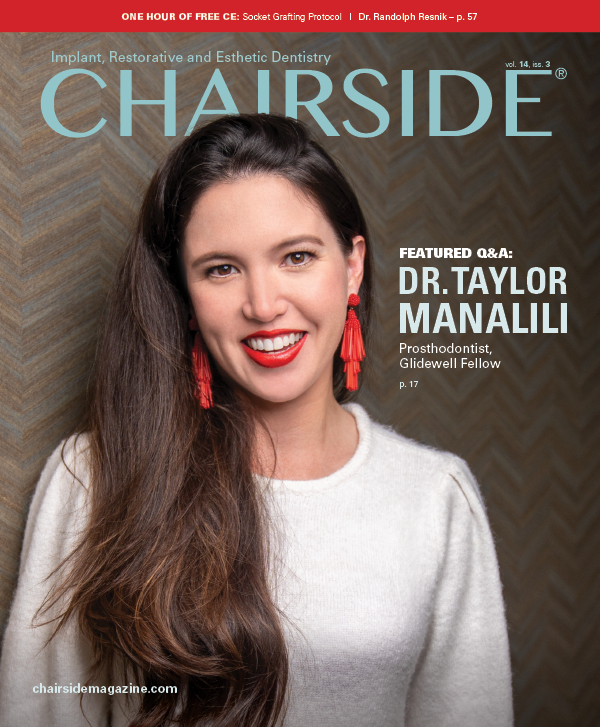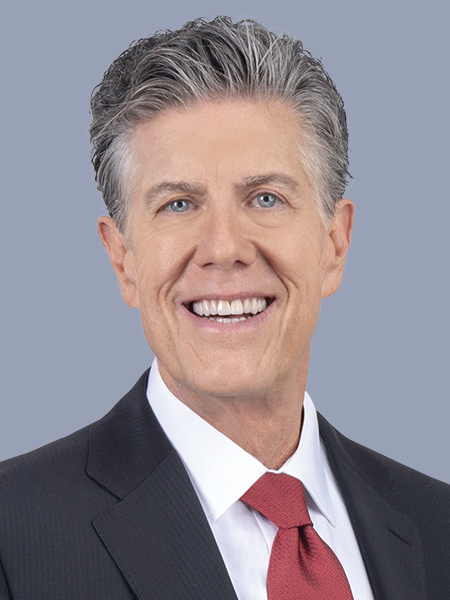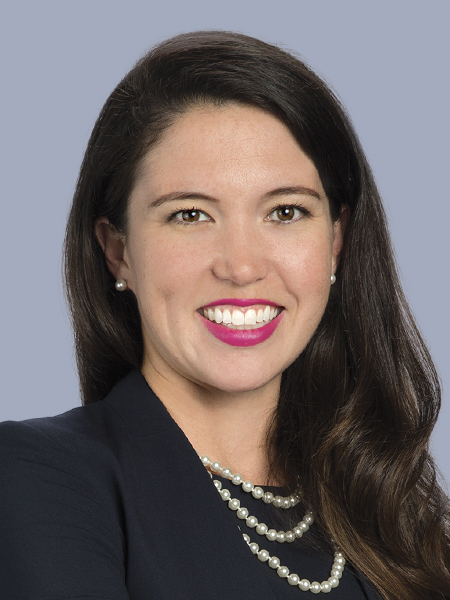Interview with Taylor Manalili, DDS
Note: The Hahn Tapered Implant System is now known as the Glidewell HT Implant System
Dr. Taylor Manalili joined Glidewell Dental in August 2018 as the first-ever Glidewell Fellow, where she conducts clinical research and practices restorative dentistry focused on implant placement, chairside restorations and full-mouth rehabilitation. She has also spoken at the Glidewell Dental Study Club and several other programs, and will be a lecturer at this year’s Glidewell Symposium. In this interview, Dr. Manalili discusses her experiences at Glidewell thus far, both in the operatory and on the podium.
DR. NEIL PARK: After earning your bachelor’s degree in chemical engineering from Northeastern University, you went to dental school at Stony Brook University — how did you decide to pursue dentistry?
DR. TAYLOR MANALILI: My older cousin is a dentist, and when I was growing up, I always heard him saying wonderful things about his career and talking about the field so passionately. In addition, my childhood best friend went through some traumatic dental experiences. As someone who was congenitally missing several teeth, she went through a myriad of orthodontic and prosthetic treatments, and I saw how those experiences affected her life for better and for worse.
NP: And what led you to go into prosthodontics after dental school?
TM: Although I received four years of very intense and useful training in dental school, I noticed that digital technology and implantology were increasingly becoming a prominent part of dentistry, and I wanted to learn more about those subjects in a formal setting.
NP: I agree. Prosthodontics was a specialty in transition around 15–20 years ago, as some prosthodontic programs were closing and others couldn’t find qualified applicants to fill their spots. I think the advent of implant dentistry made such a big difference. When you think about it, a surgically trained prosthodontist is in an ideal situation to take the lead in implant dentistry.
TM: Absolutely. Even if we’re not the ones placing the implants, it’s really useful to have that training and full understanding of what it takes to produce a successful restoration from start to finish.
NP: Right, so you’re in a great position to be a leader in the field as it goes forward. That’s fantastic. And we’re delighted to have you here as our first Glidewell Fellow. Can you tell me a little bit about how you got involved in the program?
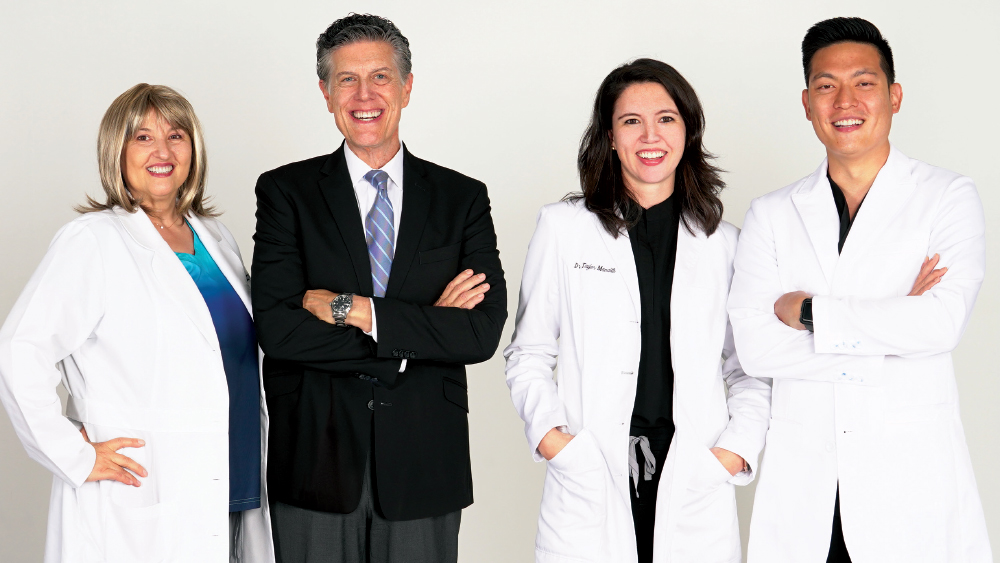
Dr. Taylor Manalili (second from right), with Glidewell Dental Director of Clinical Research Dr. Anamaria Muresan (left), Vice President of Clinical Affairs Dr. Neil Park (second from left) and Director of Clinical Technologies Dr. Justin Chi (right).
TM: I first heard about the program from my program director at Stony Brook University, Dr. Tanya Somohano Marquez, and it seemed like an excellent opportunity. Then I talked to Dr. Steven Zove, who’s Stony Brook University’s dean of clinical affairs, and that sparked my interest in the program.
NP: So what have you been up to in your time at Glidewell Dental so far?
TM: So many things. In my first year here, I’ve had the opportunity to work in the operatory with our on-site dentists, Drs. Justin Chi and Anamaria Muresan. I’ve worked on a wide variety of clinical cases, and I’ve been able to collaborate with our lab technicians.
NP: Now, let me ask you this. Glidewell has a very remarkable clinical facility that employs three full-time clinical dentists. Who do you treat in our facility?
TM: That’s a good question. We only treat the employees here at Glidewell, who number around 3,000 on this campus.
NP: And what kinds of cases do you work on?
TM: Each of us in the on-site operatory has our own specialty. I treat many implant cases, so I often work with people who have missing or terminal teeth.
NP: Had you used the Hahn™ Tapered Implant System (Glidewell Direct; Irvine, Calif.) before you got here?
TM: I hadn’t, actually, but I’ve gained a lot of experience with it since arriving at Glidewell. I think it’s a great system, and I’ve had a lot of success with it in my time here.
NP: And you’ve done other things in addition to your clinical work, including some lecturing. Can you tell us a little bit more about that?
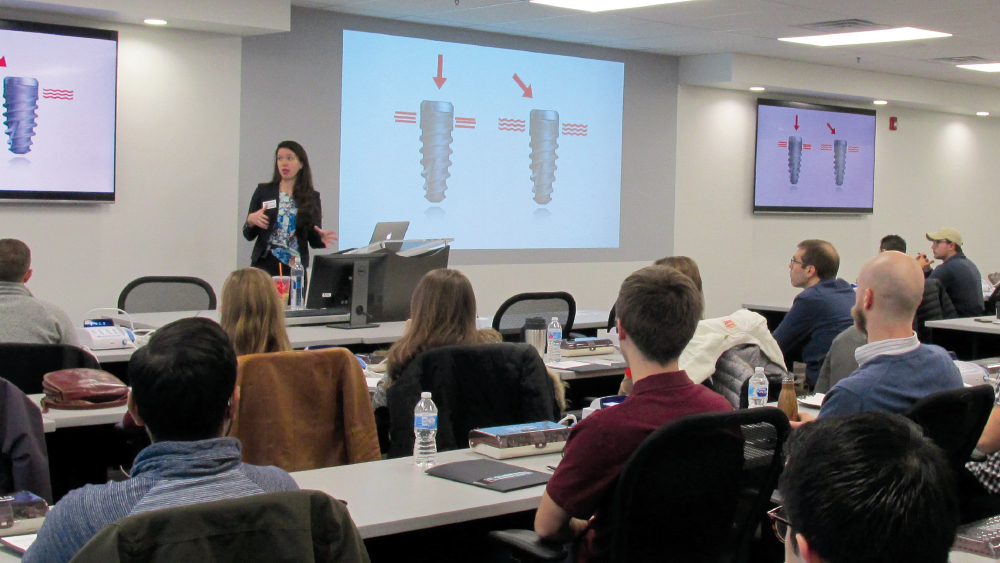
As a Glidewell Fellow, Dr. Manalili has lectured for a number of the company’s continuing education programs, including the Glidewell Dental Study Club.
TM: Definitely. That was one of the big things that caught my eye about this program, and I think it’s a reason why Dr. Zove brought it to my attention as well. I love both the clinical and teaching aspects.
NP: Well, you’re a remarkable teacher, and I know that you just helped Dr. Randolph Resnik teach the prosthodontic portion of the Misch International Implant Institute continuum. You’ve also taught for the Glidewell Dental Study Club as well as other programs, and this year you’re going to be a lecturer at the Glidewell Symposium. Congratulations!
TM: Thank you. It’s a little nerve-wracking, but I’m excited.
NP: At the California Dental Association meeting not long ago, you had a great opportunity to do a clinical demonstration. Can you tell us a little bit about that?
TM: Sure. That was quite an interesting experience. The clinical case was performed in our facility at the Glidewell International Technology Center, and then it was streamed online to the larger meeting audience at the Anaheim Convention Center.
NP: Were you nervous about that demonstration?
TM: A little bit. The lecture portion was fine — I’m used to doing that. But obviously, performing a live surgery is going to create some trepidation. We were able to conduct a fully guided surgery based on our Digital Treatment Planning department’s proposal. And it went really well.
NP: Great. And congratulations — you did a great job!
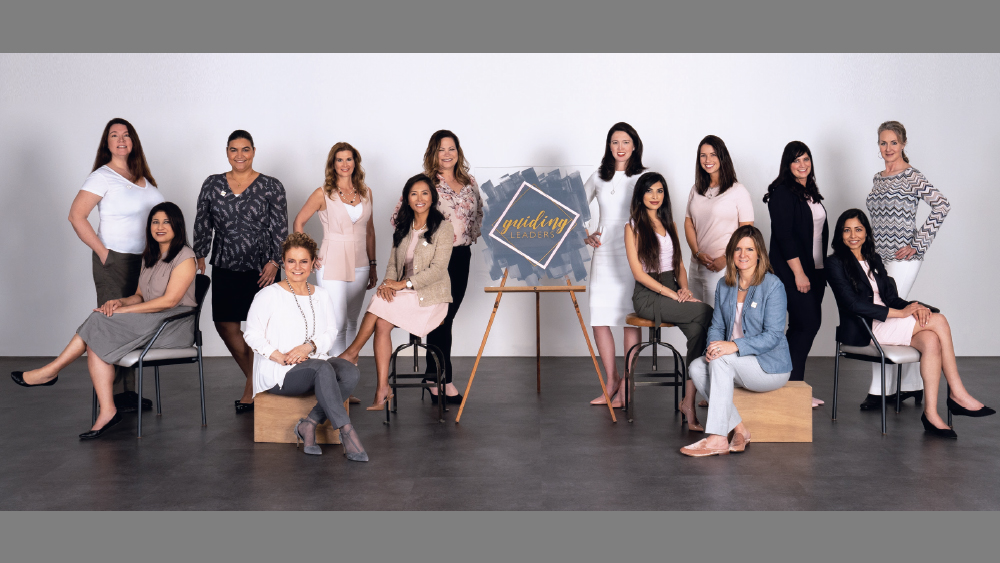
Dr. Manalili is involved with Glidewell Dental’s new Guiding Leaders program, which provides business and leadership training to women in dentistry.
TM: Thank you.
NP: Can you tell us a little bit about your participation in the new Guiding Leaders group? This is a truly unique program.
TM: Stephenie Goddard, executive vice president of Glidewell Dental, put together this amazing, yearlong leadership program for women in dentistry. She has accepted 13 wonderful women into the program, and she’s hoping to help guide them through leadership-related aspects of dentistry that we don’t learn in dental school, such as practice management and public speaking. I was asked to participate in and support the program as a Fellow, and I’m excited to be a part of it.
NP: Great. So, although Glidewell Dental has greatly expanded over the decades, it still is a dental laboratory at heart. Have you gotten involved with some of the operations of the laboratory?
TM: I have, actually. I think a great aspect of working here is that you get to work side-by-side with the lab technicians. Our operatory is right above the implant lab, so I’m able to go downstairs with my cases and discuss different protocols and other issues with the technicians. I think one of the most important jobs we have here as clinicians is trying to improve communication between the doctors and the lab technicians. Sometimes the doctor doesn’t really understand what happens operationally in the lab and the technician doesn’t understand what happens clinically. I’ve discovered that Glidewell is a far cry from the smaller laboratories I’ve worked with, where I would call the lab directly and come by for a visit to see what they do.
NP: Right. When I arrived at Glidewell about four years ago, I expected the dental laboratory to be filled with old guys wearing wax-crusted aprons. But the lab is actually full of automated mills and other incredible technology. And in fact, I’m the oldest guy here, so there’s no old guys with aprons here at all [laughs].
TM: It’s a very impressive facility. Each department alone is bigger than the small laboratories I used to work with.
NP: So how do you think you’ve made an impact? Are there any specific kinds of cases that come to mind?
TM: I’ve been helping out a lot this year with our BruxZir® Full-Arch Implant Prosthesis protocol. We’ve been working to refine the protocol by making the steps a little easier for people to follow, both for our lab and for the doctors themselves.
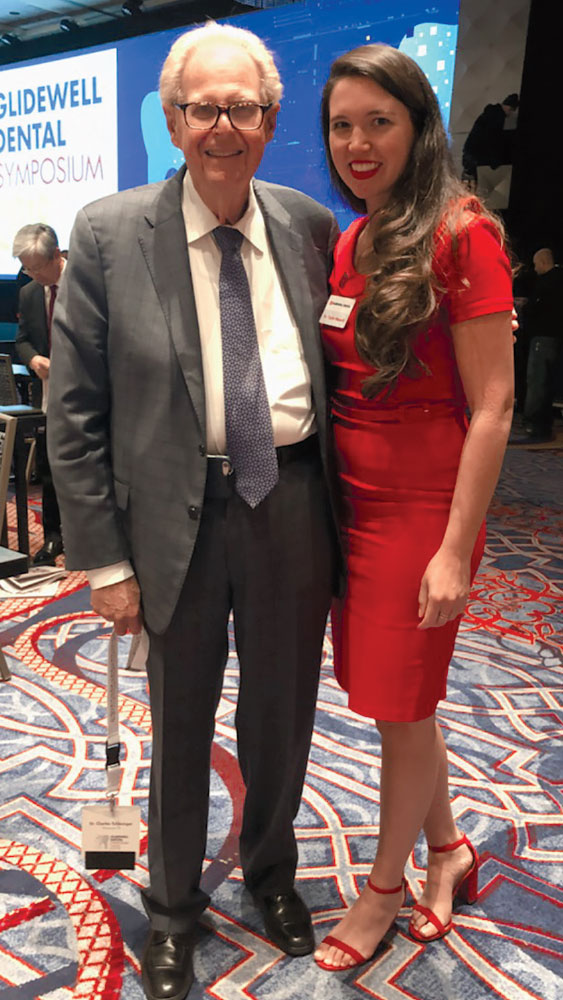
Dr. Manalili with implant pioneer Dr. Jack Hahn at the 2018 Glidewell Dental Symposium.
NP: Where was the biggest disconnect?
TM: I think the biggest disconnect in the protocol from both ends is understanding where the teeth have to go initially. It’s a big thing that shouldn’t be overlooked in the initial phase of planning implant placement. We really have to understand the space that we’re working with and where the teeth need to go from the very beginning of the restorative process.
NP: And what can be accomplished with the wax rims. The wax rim is the technician’s way of understanding what’s happening clinically. So much has to be conveyed from that.
TM: Yes. Particularly because dental schools don’t teach full dentures in that much depth anymore. There’s so much to learn, so you’re taught it, but it’s kind of glanced over. You generally don’t have as many opportunities now to play around with wax rims.
NP: Sure. And as you know, we’re working on a brand-new online learning platform for doctors, and you’re, of course, very busy creating content in this exact field so that we’ll have a very convenient reference for doctors to go over.
TM: That is my hope, yes.
NP: And how do you think being the first Glidewell Fellow will impact the rest of your career?
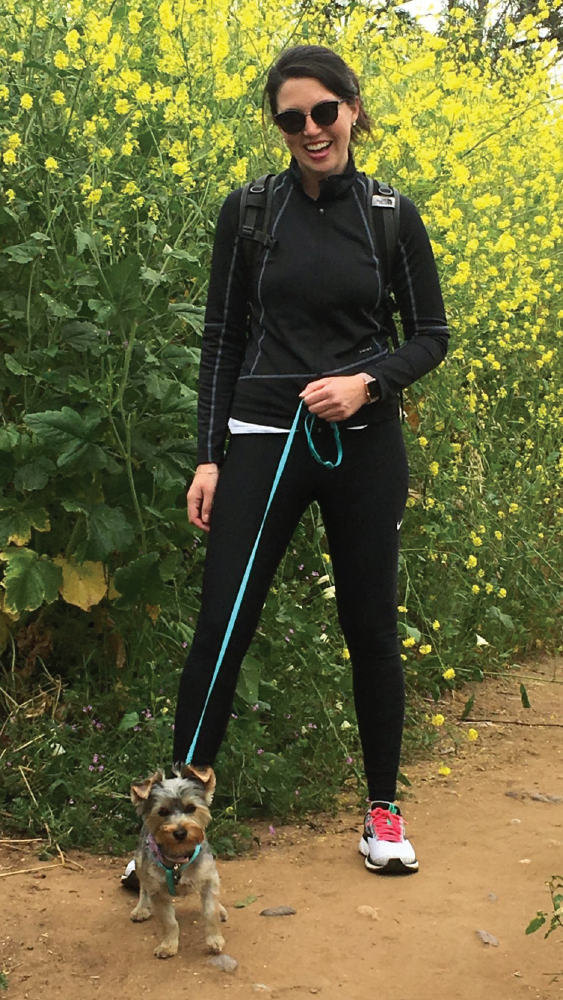
Dr. Manalili hiking with her dog during California’s wildflower super bloom in the spring of 2019.
[Being a Glidewell Fellow is] such an amazing opportunity that has opened a lot of doors already for me. ... I’m very excited to see what’s coming in the future.
TM: It’s such an amazing opportunity that has opened a lot of doors already for me. Like you said, I’ve been able to teach with the Misch Implant Institute, I’ve been able to attend a lot of CE courses, and I’ve been involved with the Guiding Leaders leadership program. In addition, I’ve been able to network with people who I never thought I would have this opportunity to work with in my first year out of residency. I’m very excited to see what’s coming in the future.
NP: Well, we are very excited to see how the rest of your career will play out. You’re going to be a great leader in prosthodontics and dentistry as a whole. Thank you so much for joining us.
TM: Thank you for having me.

